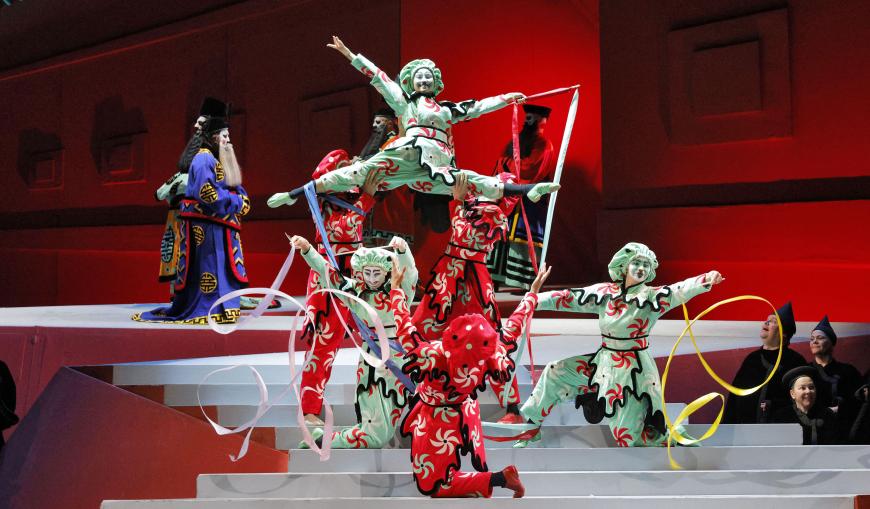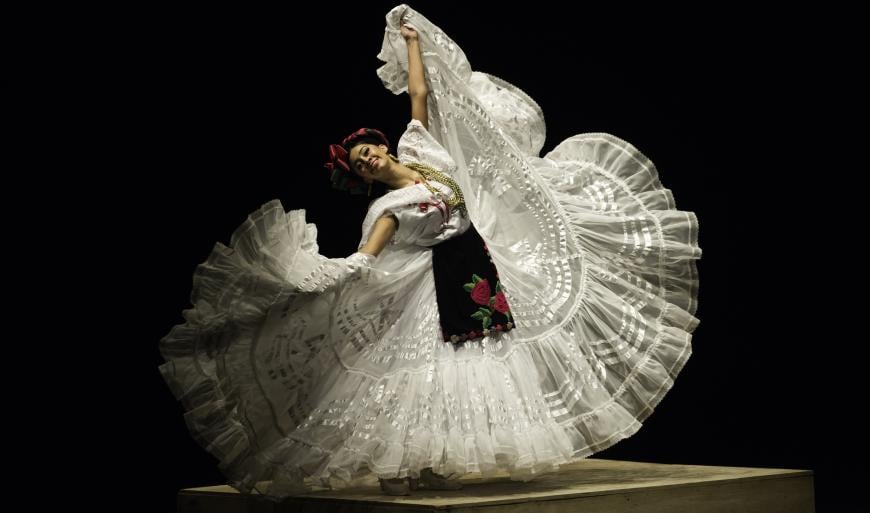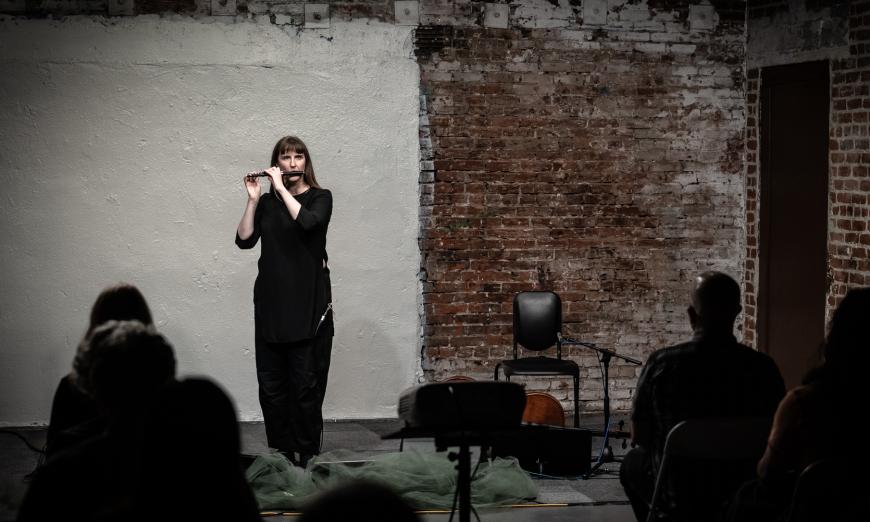
SF Classical Voice’s writers reviewed more than 200 performances in 2024, nearly half of those in Southern California. From San Diego all the way up to Ojai and points east, our writers made it to the big productions and the bare-bones recitals. For their hardest assignment all year, we asked them to whittle all of that down to three favorite performances apiece. Here are their picks for this year’s standout offerings:
Diavolo | Architecture in Motion’s Existencia (Jan. 17 and 19)

This world-premiere dance drama from Jacques Heim and his troupe Diavolo commemorated the 30-year anniversary of the 1994 Northridge earthquake. Seen at The Soraya and set to an original score performed live, this was a thrill ride of epic proportions, with dancers leaping, spinning, and performing over, under, and around an array of enormous structures, humanity ultimately prevailing. (Read SFCV’s preview of the production.) —Victoria Looseleaf
Wild Up’s Darkness Sounding (Jan. 19–28)

2024 marked the third iteration of this atmospheric festival from Wild Up. This year’s concerts, presented in collaboration with outdoor performance series Floating, took place at a hilltop eco-reserve overlooking the San Fernando Valley. One of the most immersive offerings, on Jan. 28, featured a set of compositions by Leilehua Lanzilotti, who is Native Hawaiian — fragile creations combining the subtlest tonalities of classical instrumentation with field recordings of falling rain and forest murmurs. (Read SFCV’s review of the concert.) —Jim Farber
The Rite of Spring and common ground[s] at The Music Center (Feb. 8–11)

Set to Igor Stravinsky’s iconic score, Pina Bausch’s 1975 opus The Rite of Spring, performed by some 30 dancers from 14 African countries on a stage covered in mounds of peat, dazzled audiences at the Dorothy Chandler Pavilion. Germaine Acogny and Malou Airaudo’s common ground[s] rounded out the double bill, each work dealing with sacrifice and gender relationships. This was heart-stopping, gasp-inducing theater. (Read SFCV’s review of the program.) —Victoria Looseleaf
Jordi Savall and Hespèrion XXI at St. Andrew Church (April 14)

The viola da gamba legend and his ensemble Hespèrion XXI delivered a brimming concert of music spanning 100 years between the late Renaissance and the Baroque. This was my first time experiencing these musicians’ sumptuous skill. (I’m an early-music harpist myself, so hearing harpist Andrew Lawrence King live was exhilarating to say the least.) A concert fit for kings. —Tamzin Elliott
Tatsuya Nakatani and Patrick Shiroishi at Healing Force of the Universe (April 25)

Nakatani, a powerhouse Japanese percussionist and improviser, was joined at the Pasadena record store by Shiroishi, a lithe and sensitive saxophonist. Having barely played together before, they laid down a set that had me sweating by the end. This is the true power of improvising at this level — they had me listening with my mind and body for I’m not sure how long, tears coming and going but laughs coming easily. Mingjia Chen, a delightfully acrobatic vocalist, composer, and improviser, opened the evening with percussionist Nick Hon. —Tamzin Elliott
Hunter Noack’s In a Landscape (May 2)

For sheer audacity, no performance of 2024 compared. Noack brought his roving piano recital series to Folly Mojave — the 200-plus-acre site at the intersection of the Mojave National Preserve and Joshua Tree National Park. Just getting there was a challenge, with the directions noting that off-road vehicles were recommended. The program (of Bach, Mozart, and more) would hardly qualify as unique. But amid a high-desert moonscape, with the soloist and his Steinway on a flatbed trailer and the audience listening on high-quality headphones and able to wander off into the wilderness, the recital moved into a whole other dimension. (Read SFCV’s feature about the series.) —Jim Farber
Turandot at Los Angeles Opera (May 18 – June 8)

LA Opera finally landed the famous 1992 David Hockney-designed production of Puccini’s Turandot that the company had been lusting after for decades. Hockney’s whimsical designs, saturated in red, blue, and green, were, as expected, stunning. The score was grandly served, too, by Music Director James Conlon, and Guanqun Yu’s gorgeously sung Liù was the standout vocal performance. (Read SFCV’s review of the production.) —Richard S. Ginell
The Industry’s The Comet / Poppea (June 14–23)

Directed by Yuval Sharon, this production radically paired Claudio Monteverdi’s The Coronation of Poppea with George Lewis’s The Comet, inspired by an apocalyptic 1920 short story by W.E.B. Du Bois. The audience was divided in half on either side of a merry-go-round turntable on which both operas (walled off from one another) rotated and were performed simultaneously. The result was by turns musically captivating and dramatically disconcerting. (Read SFCV’s review of the production.) —Jim Farber
Ballet Folklórico de México at the Hollywood Bowl (July 18)

Ballet Folklórico de Mêxico de Amalia Hernández made its long-awaited Bowl debut in July, with guest conductor Carlos Miguel Prieto leading the Los Angeles Philharmonic in memorable works by Silvestre Revueltas, Arturo Márquez, and Agustín Lara. Clad in resplendent costumes, the 40 dancers performed a variety of culturally rich pieces, including mambos and huapangos, with a leaping Yacqui deer dancer also making an electrifying appearance. (Read SFCV’s preview of the program.) —Victoria Looseleaf
Laurel Irene in Morton Feldman’s Three Voices (Sept. 14)

Performances of Feldman’s mesmerizing 1982 cult masterpiece, a meditation on the intersection of memory and technology, are rare and weird happenings. This thoughtful incarnation at First Congregational Church of Los Angeles, presented by the Resonance Collective, featured one live singer (Irene), accompanied by her own voice on recordings heard from two speakers. Short wordless phrases sighed and intertwined in subtly echoing patterns. Two dancers roamed around, linked by a thick white rope that seemed to pull the combining musical threads. —Harlow Robinson
Mahler’s Second at the San Diego Symphony (Oct. 4–6)

Jacobs Music Center reopened this year after a $125 million renovation that aimed to improve the acoustics and elevate the performance and stature of the San Diego Symphony. Music Director Rafael Payare and the SDSO tried out Gustav Mahler’s mighty Symphony No. 2, and the results were promising, certainly an upgrade over the old hall. (Read SFCV’s review of the concert.) —Richard S. Ginell
Rachel Beetz’s “Self Portrait” for Tuesdays @ Monk Space (Oct. 8)

Beetz, a flutist, composer, and improviser, presented a bouquet of her solo works. Magical and light, her music is rooted in the extended exploration of special techniques — in this way she accesses depth with a certain weightlessness. Luna, a collaboration with cellist and videographer Jennifer Bewerse, fit perfectly on this October night; the piece offered a delicate gaze at footage of the full moon with patience and peace and the infinitesimally shifting textures of Bewerse’s cello. (Read SFCV’s review of the concert.) —Tamzin Elliott
“Charles Ives @ 150” at Piano Spheres (Oct. 22)

Two of music’s great disrupters — Arnold Schoenberg and Charles Ives — celebrated 150th birthdays in 2024. In Los Angeles, Schoenberg, an adopted Californian, got much more attention. But Stephen Drury paid moving and nimble tribute to the cranky Connecticut Yankee in a lovingly presented evening of Ives’s knotty piano music. Accompanying the oft-revised, transcendental “Concord” Sonata were the memory-filled First Piano Sonata and the Three Page Sonata, a witty parody of Schoenberg’s dodecaphony. (Read SFCV’s review of the recital.) —Harlow Robinson
Behzod Abduraimov at Walt Disney Concert Hall (Nov. 13)

No stranger to California, the sturdy and upcoming Uzbek pianist returned with a carefully calibrated and emotionally mature program of César Franck (Prelude, Fugue, and Variation), Florence Price (Fantasie nègre No. 1), and two of his Russian soulmates, Modest Mussorgsky (Pictures at an Exhibition) and Sergei Prokofiev (a thrilling and athletic account of the 10 Pieces From Romeo and Juliet, by turns savage and tender). (Read SFCV’s review of the recital.) —Harlow Robinson
Gurrelieder at the Los Angeles Philharmonic (Dec. 13 and 15)

Zubin Mehta, who punched the music of Arnold Schoenberg into the repertoire of the LA Phil when he was the orchestra’s music director in the 1960s and 1970s, returned to lead an unforgettably eloquent, spectacular performance of Schoenberg’s colossal symphonic song cycle. We’ll be talking about this concert for years to come. (Read SFCV’s review of the concert.) —Richard S. Ginell


